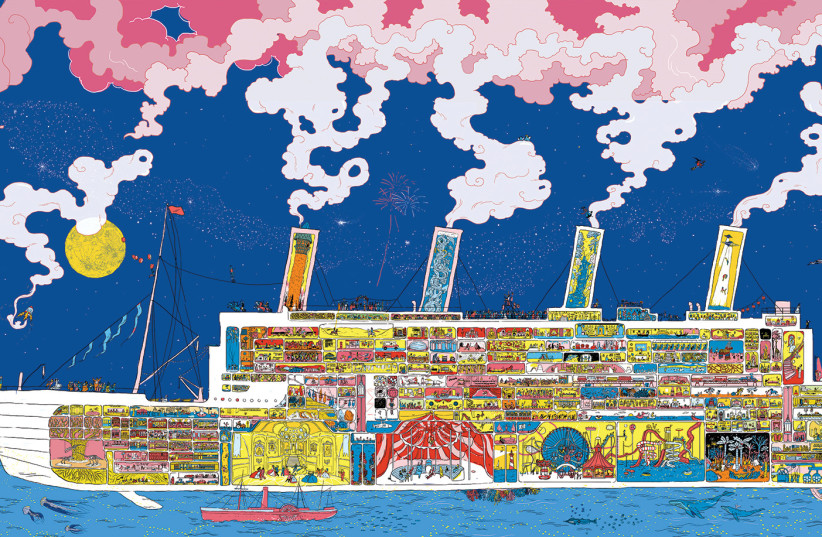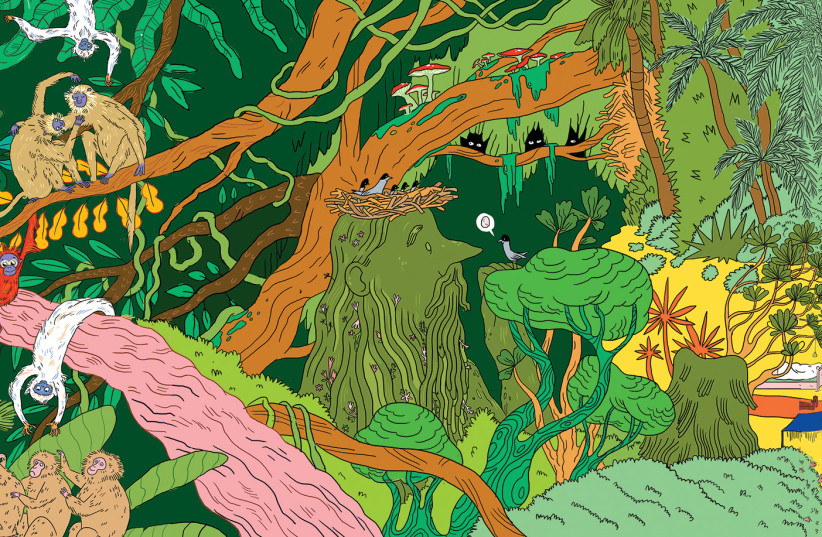There is a Hebrew expression, begova ha’einayim, which translates literally as “at eye level” or, in more realistic terms, something like “on their own terms.” The Voyage to Nowhere exhibition, which opened at Hansen House last week, neatly answers to both descriptions for junior culture consumers.
First, the polychromic frieze that runs round the pristine whitewashed walls of the venerable Hansen House first floor display space is positioned at just the right height for younger kids and their older siblings to get up close to the madcap, eye-catching head-spinning splash of color, multiple storylines, shapes, creatures – real and imagined – and fun.
Adults less than, say, 1.8 meters tall should also manage without stooping too much, and the universality of the all-inclusive content also appeals to people of all ages and cultural bents.
All of the above, and more, is currently on offer at Hansen House, courtesy of celebrated children’s books illustrator and writer Einat Tsarfati, who has put on quite a spread for our viewing and funny bone entertainment.
As you turn right from the entrance to the main building and cross the century-plus old flagstone floor, you enter a cavernous two-room space joined by an arched opening. You immediately get a sense of stepping into a time warp enclave, cloistered from street-level life around you.

The color – lots and lots of it – grabs you and draws you into a vortex from another time, another dimension, and another world. The predominant motif appears to be water. This is clearly not domestic tap water or even a gentle stream wending its natural way betwixt tranquil meadows.
Tsarfati’s aquatic-based creation is more along the lines of taking a playful, high jinks, entertainment amplifier – even if such a contraption were to exist and, in Tsarfati’s world, that is a strong possibility – and ramping it up to the proverbial 11 setting.
An artistic experience like a voyage at sea
As the exhibition explanatory notes have it: “The experience of viewing Tsarfati’s illustrations can be likened to a voyage at sea. From a distance, they appear as endless expanses of color, dotted with allusions to invisible secrets. Yet, as one dares to dive into them, they reveal hidden worlds, scenes dense with detail, encounters and figures, memories and references to the culture left behind on dry land.”
The exegetical text gets the visual effect and vibe dynamic spot-on. You are impelled to get up really close to the comic strip-like work. There is simply nothing to be done about that. The bright colors, the myriad alluring figures, fetching poses, and improbable juxtapositions all draw you into the thick of the rip-roaring merry action as strange-looking sea craft and weird and wonderful creatures crop up in all sorts of unexpected places.
AND THERE is just so much detail. Not of the overwhelming kind but rather the alluring type that makes you want to go with the cascading flow. That is exactly what Tsarfati would like us to do. “Yes, it is like a comic strip. It is like a book,” she says. Actually, several. “The exhibition takes from all sorts of books I’ve created over the years,” she adds, pointing me in the direction of a low table in the far display area which has around a dozen volumes with suitably attractive covers for us to leaf through, should we choose.
Thus far, she has put out about a dozen well-received books, some of which have been translated into 20 or more languages. Her work clearly has far-reaching appeal that draws consumers from different cultural climes. That is often indicative of quality creative work.
The referential basis for The Voyage to Nowhere, Tsarfati says, lends itself to a narrative continuum. “To me, this feels a bit like getting into a book. These are illustrations that I am familiar with in book proportions, and there is a conscious stream of connections between the books.” Not just books. “This house comes from a poster I made last year for the Outline Festival,” she notes with a nod to the annual illustration and words event in Jerusalem. “It is a sort of fusion, but there is a comic feel to it.”
There certainly is, particularly with regard to the way the frieze navigates the structural machinations. It is enticing to see, for example, how some amphibious character arcs its way around a corner. Tsarfati even managed with the fundamentally disruptive presence of such extraneous aesthetic elements, such as air vents and electrical sockets. The white slats could have stuck out like a sore thumb and abruptly arrested our spectator experience, but somehow they don’t.
The official poster for the event is a wonder in itself. You could easily spend half an hour engrossing yourself in it, with its multifarious characters in all kinds of poses and situations. There are mythological-looking figures; a couple getting down with some 50s-style boogying; fittingly, a couple of kids transfixed by a book; and bottles with slips of paper bobbing around the outsized puddle. It also appears in the larger runaround work, as a pool surrounded by greenery as an island in the larger expanse of water. Again, there are so many minutiae to catch as you glimpse hither and thither.
THAT IS part of Tsarfati’s “ulterior” motive for getting us on board the Voyage to Nowhere. By the way, the first part of the original Hebrew title of the exhibition – Hahaflaga leShumakom – relates to a sea trip or a flight of fancy. Any, or all of the above, work well.
There are foldout strips that can be picked up near the entrance, in Hebrew, which invite us to track down various items sewn into the pictorial fabric on the walls. “There are lots of things concealed in the illustrations around the space,” the introductory text explains. “Here are nine things you may be able to find.” Tsarfati then owns up to her seduction ruse. “You are also invited to look for them and find other things on the way…” As if we needed any more encouragement to dive headlong into the meandering, undulating storyline.

Going back to early artistic influences
There are references to a couple of iconic artists, with a skyward floating couple sending us in the direction of Marc Chagall, with Van Gogh’s famous Bedroom in Arles also putting in an appearance. In another, Tsarfati aims to spark the younger visitor’s imagination by declaring she would love to be able to read people’s minds and also to fly. The latter superpower appears somewhere or other in the spread. Dragons, dinosaurs, and snakes also get a slot or two. There doesn’t seem to be much Tsarfati hasn’t culled for our viewing titillation.
Perhaps she was looking to subtly introduce children to the wonders of modern painting and to sow the seeds of further investigation at a later age? Tsarfati says she is a little divided on that point. “I am a bit ambivalent about that,” she smiles. “I hope I am not being demagogic here, but I remember that I initially learned about art through comics like Asterix,” she says, referencing the beloved pint-sized Gallic character, who regularly pounded unsuspecting Roman forces into kingdom come with the help of his far sturdier pal Obelix, and a little medicinal help from the wise druid Getafix, who cooks up potions that imbue the lovable duo with inordinate strength.
Shades of modern-day sports world chemical intervention perhaps? There are other pointers to Tsarfati’s sources of inspiration, such as a couple of orangutans that put one in mind of The Jungle Book animated movie.
That harks back to the artist’s own childhood. “You can’t get away from your early influences,” she notes. “My father comes from Tunisia and made aliyah from France. I couldn’t understand French [of Franco-Belgian comics Asterix], but I used to look at the pictures. That has stayed with me.” Disney animation also figures in Tsarfati’s back catalog of evolving aesthetic awareness.
Tsarfati has really gone to town with The Voyage to Nowhere, and why shouldn’t she? It has also provided her with a rare opportunity for working in a larger format, which not only accommodates numerous figures and objects but also makes them more easily discernible to the naked eye.
“This is the first time I have worked on such a scale,” she says, adding that she was primed for it in terms of technicalities and quality. “I work with high resolution images. I do that to be able to produce small details, but I never thought about such a size. I’ve made posters, but I never thought of producing a book as big as this,” she laughs.
SIZE, SHE says, does matter when it comes to the creative side of the cultural equation. “In a sense, I feel more in my safe zone when I work on a regular book-sized format. It is a bit of an overwhelming experience, seeing everything on such a scale. I feel as if I have stepped into one of my own books. It is a very strange experience for me.”
Judging by the expressions on the kids’ faces there, and their excitement at espying a new character or item in the pictorial storyline sequence, Tsarfati needn’t have worried about the possibility of the younger crowd drowning in the abundance of finer details.
There is also some thinly veiled biblical content in the exhibition, including Jonah and his time in the whale’s belly, even though the prophet doesn’t actually appear in the slot. “I thought of putting Jonah in, but in the end I went for Pinocchio,” Tsarfati laughs. There’s also a place for the Titanic in there, which some of the visiting public may have heard of from the 1997 blockbuster movie with Leonardo DiCaprio et al. Nothing like keeping your viewing public guessing, and possibly engaging in a little dome scratching to pull us into the storyboard action.
She admits to fusing her textual and pictorial narratives with a little educational content. “I have a book called Sandcastle,” she says. “That was inspired by a visit we paid to the beach with our daughters. They built a wonderful sandcastle and enjoyed it so much. But, in the end, it was washed away by the sea.” Tsarfati feels the message subtext is important ,too. “That happens to us all,” she laughs. “I think children should know that from a young age.”
The Voyage to Nowhere gives the impression of coming from a stream-of-consciousness mindset, which is similar to the way Tsarfati produces her books. “I have the basic storyline, but I don’t always know how it is going to pan out.” That is partly down to the creative process. “I don’t always draw in a linear way,” she adds. “I’ll add a scene, and take one off and add another, and see how things go.”
Things were going pretty well at Hansen House last Friday, and the fun exhibition will no doubt continue to draw the crowds through the summer vacation and the holiday period. ❖
The Voyage to Nowhere closes on October 5. For more information: hansen.co.il/en/event/the-voyage-to-nowhere/
